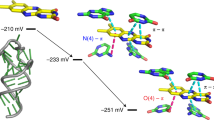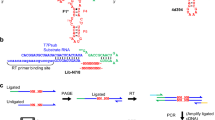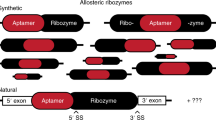Abstract
We report an RNA molecule that exhibits activity analogous to that of alcohol dehydrogenase (ADH). Directed in vitro evolution was used to enrich nicotinamide adenine dinucleotide (NAD+)–dependent redox-active RNAs from a combinatorial pool. The most active ribozyme in the population forms a compact pseudoknotted structure and oxidizes an alcohol seven orders of magnitude faster than the estimated spontaneous rate. Moreover, this ADH RNA was coupled with a redox relay between NADH and flavin adenine dinucleotide to give a NAD+-regeneration system. Our demonstration of the redox ability of RNA adds support to an RNA-based metabolic system in ancient life.
This is a preview of subscription content, access via your institution
Access options
Subscribe to this journal
Receive 12 print issues and online access
$189.00 per year
only $15.75 per issue
Buy this article
- Purchase on Springer Link
- Instant access to full article PDF
Prices may be subject to local taxes which are calculated during checkout




Similar content being viewed by others
References
Berg, J.M., Tymoczko, J.L. & Stryer, L. Biochemistry (Freeman, New York, 2002).
Gray, H.B. & Ellis, J.W.R. Electron transfer. In Bioinorganic Chemistry (eds. Bertini, I., Gray, H.B., Lippard, S.J. & Valentine, J.S.) 315–363 (University Science Books, Sausalito, California, USA, 1994).
Gilbert, W. The RNA world. Nature 319, 618 (1986).
White, H.B., III. Coenzymes as fossils of an earlier metabolic state. J. Mol. Evol. 7, 101–104 (1976).
Joyce, G.F. & Orgel, L.E. Prospects for understanding the origin of the RNA world. In The RNA World (eds. Gesteland, R.F., Cech, T.R. & Atkins, J.F.) 49–77 (Cold Spring Harbor Laboratory Press, New York, 1999).
Benner, S.A., Ellington, A.D. & Tauer, A. Modern metabolism as a palimpsest of the RNA world. Proc. Natl. Acad. Sci. USA 86, 7054–7058 (1989).
Bertini, I. & Luchinat, C. The reaction pathways of zinc enzymes and related biological catalysts. In Bioinorganic Chemistry (eds. Bertini, I., Gray, H.B., Lippard, S.J. & Valentine, J.S.) 37–106 (University Science Books, Sausalito, California, USA, 1994).
Konarska, M.M., Grabowski, P.J., Padgett, R.A. & Sharp, P.A. Characterization of the branch site in lariat RNAs produced by splicing of mRNA precursors. Nature 313, 552–557 (1985).
Burgin, A.B. & Pace, N.R. Mapping the active site of ribonuclease P RNA using a substrate containing a photoaffinity agent. EMBO J. 9, 4111–4118 (1990).
Nakamura, M., Toda, M., Saito, H. & Ohkura, Y. Fluorimetric determination of aromatic aldehydes with DDB. Anal. Chim. Acta. 134, 39–45 (1982).
Blankenhorn, G. Intermolecular complexes between N-methyl-1,4-dihydronicotinamide and flavines. The influence of steric and electronic factors on complex formation and the rate of flavine-dependent dihydronicotinamide dehydrogenation. Biochemistry 14, 3172–3176 (1975).
Kimura, E., Shionoya, M., Hoshino, A., Ikeda, T. & Yamada, Y. A model for catalytically active zinc(II) ion in liver alcohol dehydrogenase: a novel “hydride transfer” reaction catalyzed by zinc(II)-macrocyclic polyamine complexes. J. Am. Chem. Soc. 114, 10134–10137 (1992).
Shinkai, S., Era, H., Tsuno, T. & Manabe, O. Oxidation of alcohols via alkoxymagnesium halides by an NAD+ model compound. Bull. Chem. Soc. Jpn. 57, 1435–1436 (1984).
Mathews, D.H., Sabina, J., Zuker, M. & Turner, D.H. Expanded sequence dependence of thermodynamic parameters improves prediction of RNA secondary structure. J. Mol. Biol. 288, 911–940 (1999).
Sassanfar, M. & Szostak, J.W. An RNA motif that binds ATP. Nature 364, 550–553 (1993).
Jiang, F., Kumar, R.A., Jones, R.A. & Patel, D.J. Structural basis of RNA folding and recognition in an AMP-RNA aptamer complex. Nature 382, 183–186 (1996).
Feigon, J., Dieckmann, T. & Smith, F.W. Aptamer structures from A to zeta. Chem. Biol. 3, 611–617 (1996).
Shinkai, S., Yamada, S. & Kunitake, T. Coenzyme models. 10. Rapid oxidation of NADH by a flavin immobilized in cationic polyelectrolytes. Macromolecules 11, 65–68 (1978).
Hamachi, I. & Kobuke, Y. Facilitated electron transfer from NADH to flavolipid bound in ammonium bilayer. J. Chem. Soc., Chem. Commun., 130–131 (1989).
Kokubo, T., Sassa, S. & Kaiser, E.T. Flavohemoglobin: a semisynthetic hydroxylase acting in the absence of reductase. J. Am. Chem. Soc. 109, 606–607 (1987).
Ferre-D'Amare, A.R., Zhou, K. & Doudna, J.A. Crystal structure of a hepatitis delta virus ribozyme. Nature 395, 567–574 (1998).
Hilbers, C.W., Michiels, P.J. & Heus, H.A. New developments in structure determination of pseudoknots. Biopolymers 48, 137–153 (1998).
Yarus, M. Boundaries for an RNA world. Curr. Opin. Chem. Biol. 3, 260–267 (1999).
Bartel, D.P. & Unrau, P.J. Constructing an RNA world. Trends Cell Biol. 9, M9–M13 (1999).
Huang, F., Bugg, C.W. & Yarus, M. RNA-catalyzed CoA, NAD, and FAD synthesis from phosphopantetheine, NMN, and FMN. Biochemistry 39, 15548–15555 (2000).
Breaker, R.R. & Joyce, G.F. Self-incorporation of coenzymes by ribozymes. J. Mol. Evol. 40, 551–558 (1995).
Burgstaller, P. & Famulok, M. Isolation of RNA aptamers for biological cofactors by in vitro selection. Angew. Chem. Int. Ed. Engl. 33, 1084–1087 (1994).
Lauhon, C.T. & Szostak, J.W. RNA aptamers that bind flavin and nicotinamide redox cofactors. J. Am. Chem. Soc. 117, 1246–1257 (1995).
Roychowdhury-Saha, M., Lato, S.M., Shank, E.D. & Burke, D.H. Flavin recognition by an RNA aptamer targeted toward FAD. Biochemistry 41, 2492–2499 (2002).
Cadwell, R.C. & Joyce, G.F. Mutagenic PCR. PCR Methods Appl. 3, S136–S140 (1994).
Acknowledgements
This work was supported by a grant from the US National Science Foundation (H.S). S.T. acknowledges the JSPS Research Fellowships for Research Abroad. We thank all members of Suga and Bright groups, in particular D.R.W. Hodgson and H. Murakami for invaluable discussions and C.A. Munson for assistance with fluorescent measurements.
Author information
Authors and Affiliations
Corresponding author
Ethics declarations
Competing interests
The authors declare no competing financial interests.
Supplementary information
Rights and permissions
About this article
Cite this article
Tsukiji, S., Pattnaik, S. & Suga, H. An alcohol dehydrogenase ribozyme. Nat Struct Mol Biol 10, 713–717 (2003). https://doi.org/10.1038/nsb964
Received:
Accepted:
Published:
Issue Date:
DOI: https://doi.org/10.1038/nsb964
This article is cited by
-
An RNA aptamer that shifts the reduction potential of metabolic cofactors
Nature Chemical Biology (2022)
-
Structure and mechanism of the methyltransferase ribozyme MTR1
Nature Chemical Biology (2022)
-
The block spectrum of RNA pseudoknot structures
Journal of Mathematical Biology (2019)
-
The plasticity of redox cofactors: from metalloenzymes to redox-active DNA
Nature Reviews Chemistry (2018)
-
Statistics of topological RNA structures
Journal of Mathematical Biology (2017)



